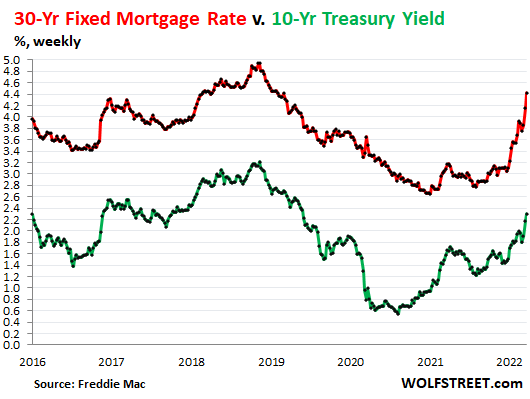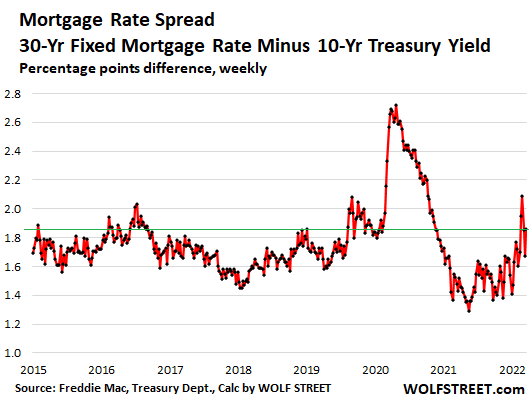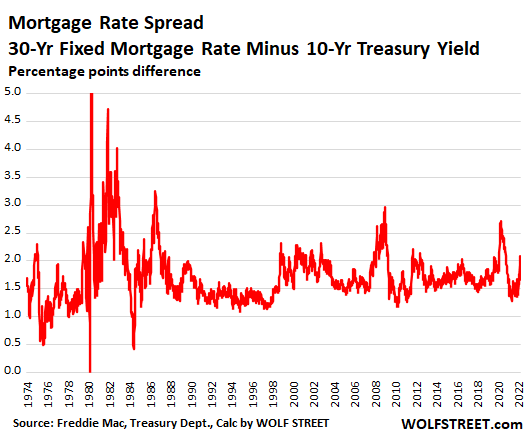March 25, 2022 | Mortgage Rates Are Rising Much Faster than Treasury Yields. What’s the Deal?

The average 30-year fixed mortgage rate tracks the 10-year Treasury yield, running roughly in parallel but higher. It tracks the 10-year yield because the average 30-year mortgage gets paid off in just under 10 years, either through the sale of the home, or through a refi. But they don’t move in lockstep, and the difference between the two – the spread – has been widening sharply, with mortgage rates suddenly rising much faster than the 10-year yield.
The US Treasury 10-year yield has shot up since the Fed made its infamous “pivot” in the fall of 2021, from willfully ignoring and assiduously brushing off the incredibly spiking inflation to actually acknowledging, even if tepidly at first, its existence and persistence.
Back in August 2021, the 10-year yield was still at around 1.3%. Today it’s 2.34%, having gained 1.03 percentage points in seven months. Over the same period, the average 30-year fixed mortgage rate, as tracked by Freddie Mac, jumped by 1.55 percentage points, from 2.87% to 4.42%:

The chart above shows what happened during the March 2020 chaos, when the Fed cut its policy rates to near 0% and announced a huge QE program which caused the 10-year Treasury yield (green line) to plunge, while mortgage rates just continued their methodical decline that lasted through December 2020.
That decline in mortgage rates was kicked off in late November 2018, when Powell, getting hammered on a daily basis by Trump, caved and communicated that the Fed would soon stop tightening.
At the time, inflation was below the Fed’s target, and the Fed was hiking rates that were already above CPI and it was reducing its balance sheet at a rate of about $50 billion a month (QT). Housing was getting hit, and stocks were tanking, and Trump, who’d taken ownership of the Dow, had had it.
The fact that the 10-year yield plunged in March 2020 while mortgage rates were only slowly declining caused the spread between the two to blow out. It maxed out at the end of April at 2.73 percentage points.
The average 30-year fixed mortgage rate continued to drop until it hit a historic low in December 2020 of 2.66%.
But the 10-year Treasury yield had started rising four months before mortgage rates started rising, bouncing off its historic low of 0.55% in August, causing the spread between the two to narrow. By December 2020, when mortgage rates had hit their low point, the 10-year Treasury yield had risen to 0.9%. And the spread continued to narrow into 2021.
Part of what contributed to the very low mortgage rates in 2021 was the narrow spread between the 10-year Treasury yield and the 30-year mortgage rates. At the time, it ran in the range between about 1.3 percentage points and 1.6 percentage points.
But in January 2022, the spread suddenly started widening, with mortgage rates rising much faster than Treasury yields. As of the latest weekly mortgage rate, the spread has reached 1.81 percentage points, after having hit 2.09 percentage points in early March. Note the increasing volatility of the spread:

Long-term patterns show just how much the spread can widen. The massive widening in March 2020 and during the Financial Crisis occurred because the Fed aggressively pushed down Treasury yields while mortgage rates lagged.
But in era between the mid-1970s and the mid-1980s, the Fed was aggressively pushing up Treasury yields to battle the markets with massive rate hikes. And mortgage rates in 1980 — like today — were running ahead of the 10-year Treasury yield as lenders were trying to deal with inflation. Eventually, Treasuries caught up, and then there were massive rate cuts, followed by more massive rate hikes, followed by massive rate cuts, and the spread blew out and shrank with huge volatility:

The current situation – an incredibly spiking inflation that the Fed is belatedly getting serious about – is much closer to the scenario of the 1970s and 1980s, than it is to the Financial Crisis and the March 2020 crisis. During the latter two, spreads widened because the Fed pushed down Treasury yields while mortgage rates lagged. Now the spread is widening because mortgage rates are running ahead and are rising faster than the 10-year yield. It’s likely that the spread will be very volatile, and potentially very wide for certain periods, with mortgage rates potentially outpacing Treasury yields by a wide margin during these periods, before Treasury yields catch up or mortgage rates back off.
STAY INFORMED! Receive our Weekly Recap of thought provoking articles, podcasts, and radio delivered to your inbox for FREE! Sign up here for the HoweStreet.com Weekly Recap.
Wolf Richter March 25th, 2022
Posted In: Wolf Street











